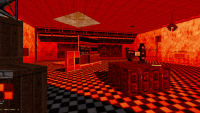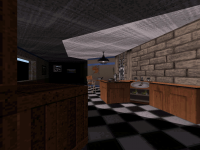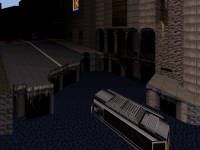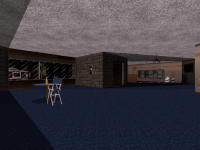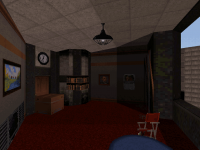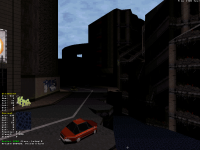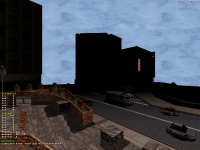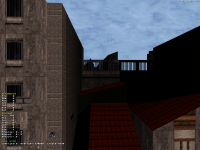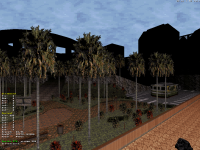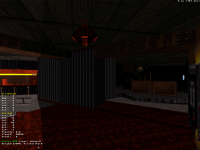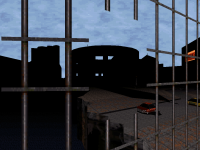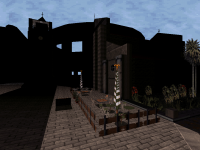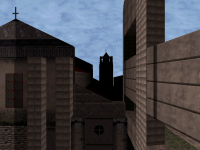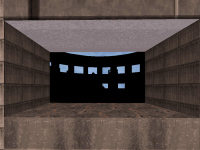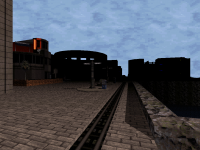The Watchtower, on 09 December 2020 - 11:34 PM, said:
Just another thing I want to point out: colours. I saw this last picture you posted and thought about the chair is red but the table is blue, which is a big no-no in real life, most decorators won't recommend that. And with that said, overriding the base palette rarely works for the game, it only looks good when the entire room gets a colour (like in your picture on the top of the page, which looked awesome), and even that only in some "very special" areas, and if the base colour is blue, more colours can be applied accordingly. I often saw in general that trashcans or fake doors for example got red colour and it doesn't exactly look great. Also I'm not a big fan of palette monsters, luckily people nowadays stopped using them, it was a big error in 90s mapping, but palette monsters should only appear if they add special attack type. Maybe they can work if all of them are replaced in a map, ie. a pitch black in a horror map looks good, or special ones in snow maps.
Honestly, in just three posts, by spotting something odd about the colors of the settings here and there (in this case the chair and table) you're actually closer to figure out certain background elements about the project I never really disclosed publicly, but have been secretly waiting for people to piece together from the screenshots eventually (that's a passive and anecdotal wait though, as it's nothing important), and that's since I started the project over a year ago. For now, I'll just say I don't disagree and you're actually onto something unknowingly, which says a lot about the sharpness of your observation. Those objects are indeed those colors for a reason. It's not the first time too, for instance you were also onto something with the example of the KTIT sign.
Generally speaking I feel like over the recent years I've been learning to use colors for two purposes, 1/ color coding certain areas of the levels for the player to easily identify which place is crucial or just secondary (also punctuating the area with visible landmarks to guide them around the bigger levels), as in a way they will be drawn to bright colors and lights just like insects (I just thought of the analogy but maybe we're actually talking the very same instinctual pattern?), and 2/ establishing a base color theme for the level which I find takes a bit of science (and subtlety) if you're trying to build up and nurture a unique vibe as opposed to clashing against the base game's default vibe all the time (which is probably what's generally off-putting in palette abuse).
Using only the strong, 'complete' palettes like 1, 2 or 8 for whole rooms (usually paired up with strong shading and stark contrast, maybe with some flashing or Cyclers) is what the base game traditionally did but lately I've actually been getting some cool results using pal 17 and 19 for more subtle touches here and there that I don't think look out of place and actually work with the environment, including the surrounding light effects and either stronger or more plain tones, which in a way feels like it adds an extra layer of depth to the original graphics and rhythm to the navigation, at least the way I've been doing it so far for this project. Not falling into the world of abominations is a fine line, but I've been trying to watch my step walking it (I guess sometimes I may still trip). Funnily enough, I'm a lot less drawn to the most 'brutal' palettes these days like pal 7 and 24 that really ruin most sceneries instead of embellishing them (even the red bushes in this current map are pushing it to me, but I needed the variation and their position will signify the one of items), when ten years ago they were my go-to's.
This leads me to a random observation I was just making to myself about how palettes are generally incompatible with working light effects (the first light change will effectively cancel it in-game, ruining the coherence unless the effect is put to good use on purpose), and that's probably why the base game never really does odd palettes - part of that is because the textures were tailor-fit to the intended vibe to begin with anyway with no need for the mappers to look for alternatives, but part is also because at the time Build as a whole was new and exciting to work with - a craft which didn't comprise just doodling little rooms and hallways, but also using the power of the new light effects that we actually might be taking for granted now, after seeing them for years. I actually feel like those light effects got old (
not tired; done right, they're timeless) and lost their flashy aspect - no pun intended - not long after the release of Duke 3D, possibly around the time Quake dropped, so a lot of user mappers past 1997 just stopped caring so much about them - like an old toy - and instead naturally started favoring the possibilities of palettes in their approach to making unique pieces. Now the habit has kind of established itself as a tradition over time and practice but since it'll always be incompatible with working lights per se, those have become underused in turn. When you think about it though, in 1996 every user map no matter how shit at least had a couple of light effects thrown in and, funnily enough, usually those were the best part of them since they're essentially pre-programmed with only minimal intervention required from a fallible human author (which just comes down to defining the trigger - if any - and contrast). Then as soon as tech moved ahead, it's as though a lot of people got bored of them and focused on a different direction.
Anyway, I was thinking that to myself because over the course of this past year I've been noticing a natural shift in my style where I'll design more sections in my maps around the idea of working lights, and I find it to be a completely different approach from the common, more explicit detailing style. Before you even implement it, you have to work the areas around the limitations of the effect (and there are plenty; sectors only being able to keep track of one base value for all walls, floors and ceilings is quite the big, annoying one), shade everything first and only then you think textures and colors, which is the opposite of settings that would primarily aim at being descriptive, yet an aspect that should never be neglected when working on a scene. Placing wall sprites and all is the function of a set dresser when as an author it's important to remember how you're not just that but also the director of the whole cinematic experience.
The Watchtower, on 09 December 2020 - 11:34 PM, said:
Also, seeing your wall sprites on your initial shots, sometimes I got the impression you should use custom textures in your maps. I know it's not an easy job and you might need help for that, but it would make these areas more interesting and special, maybe some stuff from ROTT or LameDuke can be used here and there.
It's cool seeing you point this out as I've been debating the issue for a while myself, in the end for this project I don't want new textures because a big part of the charm here for me is to reinterpret the old ones in contexts that feel different every time yet aren't that much of distorted stretches and do feel credible in-game, but your point about palette'd up aliens is a hot one as I would like a few new enemies in there (I know exactly which ones) and could use a hand for those, except I don't even know where to begin to edit .art and so far that's not been my priority yet, the mapping has been, I haven't even coded shit. Jimmy might or might not be on it sooner or later. For now I was thinking of just using colored enemies with different behavior as placeholders, but what I have in mind would work a lot better. Spending three years on the maps just to release them with colored fucks in them as opposed to real bonus content would be a bit of a downer even though I think I could make that work too.
